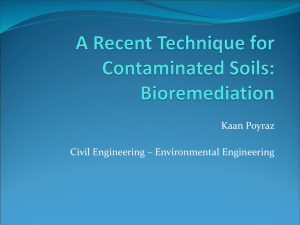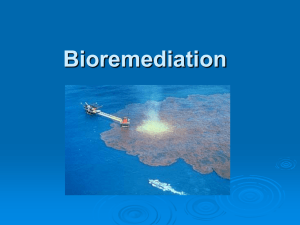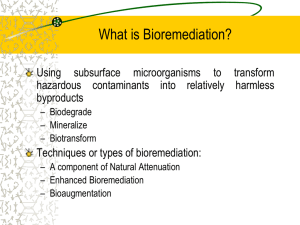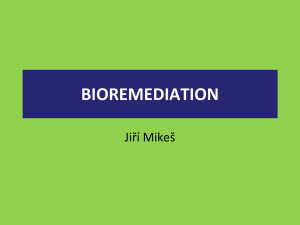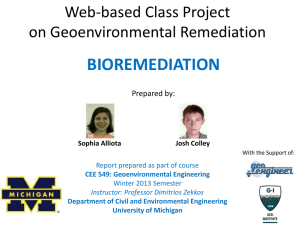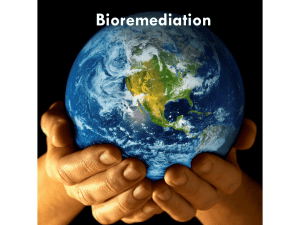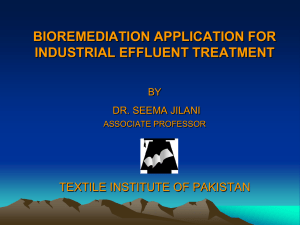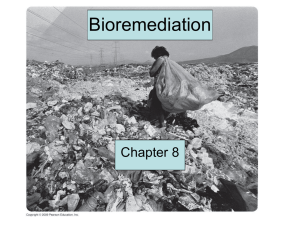Bioremediation Methods for Oil Spills
advertisement
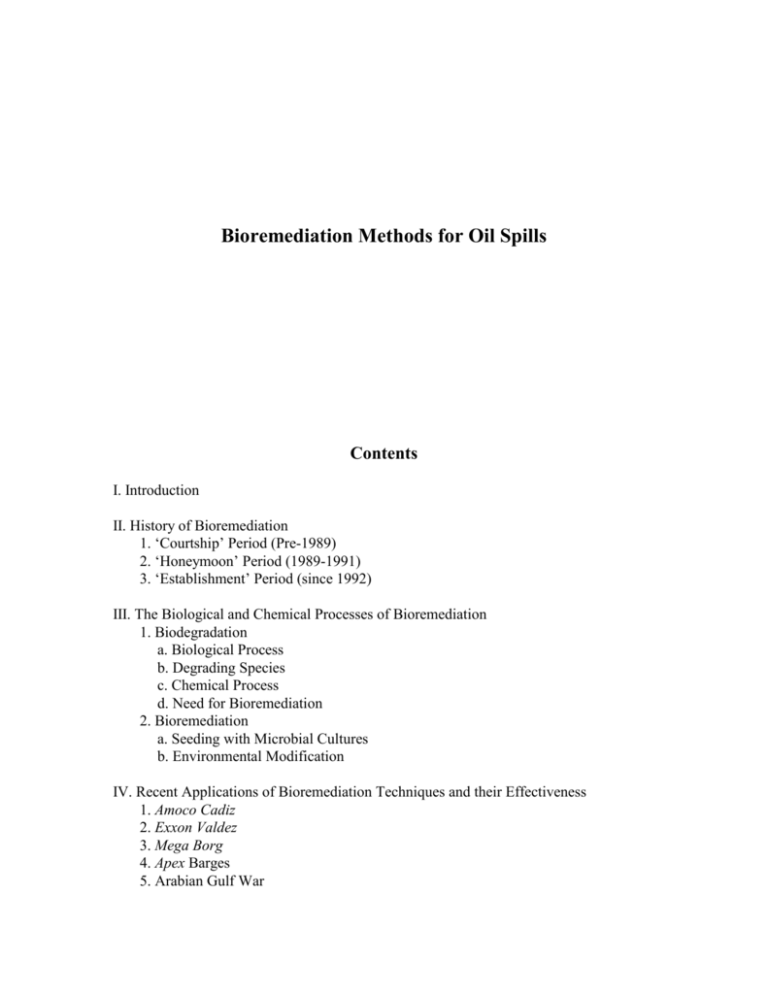
Bioremediation Methods for Oil Spills Contents I. Introduction II. History of Bioremediation 1. ‘Courtship’ Period (Pre-1989) 2. ‘Honeymoon’ Period (1989-1991) 3. ‘Establishment’ Period (since 1992) III. The Biological and Chemical Processes of Bioremediation 1. Biodegradation a. Biological Process b. Degrading Species c. Chemical Process d. Need for Bioremediation 2. Bioremediation a. Seeding with Microbial Cultures b. Environmental Modification IV. Recent Applications of Bioremediation Techniques and their Effectiveness 1. Amoco Cadiz 2. Exxon Valdez 3. Mega Borg 4. Apex Barges 5. Arabian Gulf War V. Conclusion Bibliography Bioremediation Methods for Oil Spills Abstract. The increasing number of marine oil spills asks for effective solutions for the environment. Bioremediation techniques have become a major mechanism for removing oil residues on the affected shorelines. Among the different techniques to enhance natural biodegradation by indigenous microorganisms, seeding of new bacteria and fertilizing the indigenous populations have attracted the most interest. The application of nutrients as nitrogen and phosphorus in the form of fertilizers have shown to be most effective in accelerating the biodegradation process and at the same time to be environmentally safe. I. Introduction Since the freighter Pallas caused the worst oil pollution of the tidel shallows in the North Sea last November, thousands of sea birds and probably numerous other species lost their lives in the polluted water. The responsible parties have not yet taken any measures to mitigate the damage, neither have they provided for the prevention of a similar catastrophe in the future. This is especially striking as the first devastating oil spill occurred no less than ten years ago, when the tanker Exxon Valdez ruptured in Prince William Sound. The number of oil tanker accidents is increasing with the amount of oil transported on the seas. In 1988, 1050 billion tons of crude oil has been ‘on the road’ (Frees, 1992). A way to mitigate the effects of oil spills is bioremediation. Bioremediation is a process by which chemical substances are degraded by bacteria and other microorganisms. The use of these microorganisms has been successfully applied for the treatment of waste and wastewater in controlled systems. Several research studies have recently been performed to investigate the use of bioremediation for oil-spill cleanup in seawater, freshwater and terrestrial areas. The technique has been found to have a potential for broad applications in terrestrial and freshwater environments for treating soils and sediments contaminated with oil and other substances, as well as for coastal environments impacted by oil spills. Water is a more sensitive medium than soil and requires different remediation techniques. Spills to surface water are easier to clean up than spills to groundwater, for obvious reasons. It is not only much harder to see the extent of the contamination, but also to remove the source of the contamination as, for example, a leaking underground storage tank. This paper will focus on the use of bioremediation for marine (surface water) oil spills. Part II will briefly describe the development of bioremediation techniques. Part III will explain the biological and chemical processes of bioremediation, while Part IV will have a look at a few recent applications of this technique after major oil spills and evaluate their effectiveness. Part V will draw a conclusion. II. History of Bioremediation Bioremediation is not a new concept. Microbiologists have studied the process since the 1940s. However, bioremediation became known to a broader public in the U.S. only in the late 1980s as a technology for cleanup of shorelines contaminated with spilled oil. The Exxon Valdez oil spill in 1989 in Prince William Sound, Alaska was the catalyst for this attention. In the years since 1989, bioremediation has become a technology that is discussed, applied, and considered in many different circumstances (Hoff, 1993). The story of bioremediation and its recent development as an oil spill response technology provides an interesting example of how a new environmental technology comes into being. Based on the U.S. experience (highly influenced by the Exxon Valdez oil spill), the history of bioremediation in spill response can be divided into three development periods (after Hoff, 1993): the ‘courtship’ period until 1989, the ‘honeymoon’ period from 1989 until 1991, and the ‘establishment’ period since 1992. 1. ‘Courtship’ Period (pre-1989) The first ‘courtship’ period was primarily a research period, when bioremediation was little known outside the microbiology or hazardous waste community. Many published articles from the 1970s and earlier documented the process of microbial degradation of oil, both in the laboratory and in field trials. A number of scientific papers on this topic were published during the 1970s and 1980s, including several review papers covering mechanisms of biodegradation, and papers presenting results from controlled field experiments measuring degradation rates in various environments. Several studies following major oil spills like the Amoco Cadiz measured oil degradation in the environment and confirmed previously published results from laboratory studies (Hoff, 1993). These works established a basic understanding of biodegradation of oil as an important component of the process known as weathering. Weathering encompasses the microbial and physical processes (photodegradation, tidal and wave action) that promote chemical breakdown of the oil molecules. During the 1980s numerous commercial products were developed for use as bioremediation agents. Some of these products primarily used nutrients, but the majority were derived from the growing biotechnology industry and included microbes of various kinds. Still, bioremediation had not been applied to any major marine oil spills in the U.S. 2. ‘Honeymoon’ Period (1989-1991) Between 1989 and 1991, bioremediation experienced its ‘honeymoon’ period receiving wide attention and interest. At the end of the honeymoon period came a time of disillusionment as the promise of the technology was not always born out by its use in real situations. The Exxon Valdez ran aground in Prince William Sound, Alaska in March, 1989. During the first weeks after the spill, responders were inundated with offers of help and with advertisements for products that would clean up the crude oil then spreading over 500 km of coastline in Prince William Sound. Bioremediation agents of all kinds were amoung these products. At the time, no framework was in place to test or evaluate the numerous offers that were presented. A committee of Federal and State authorities was established to develop a protocol for evaluating these products and to select the most promising for future testing. These protocols were later used as a starting point for a generic set of bioremediation testing protocols developed by the U.S. Environmental Protection Agency (EPA). EPA was a strong impetus for using bioremediation during the Exxon Valdez. In the spring of 1989, EPA conducted a series of lab an field studies investigating potential bioremediation techniques to use on oiled shorelines in Prince William Sound. Although controversies evolved about some of the bioremediation products tested and used (as will be further explained below), there is little doubt that the use of bioremediation in Alaska catalysed its use in other regions. Prior to 1989, there were no documented uses of this technology on marine oil spills; during 1990, bioremediation was used (on a trial basis) at a total of four US spills: Prall’s Island in New Jersey, Seal Beach in California, and the Apex barges and Mega Borg spills in the Gulf of Mexico. The honeymoon period for bioremediation was ending in late 1990 and 1991 as results from monitoring conducted at several bioremediation applications became available. None of the studies conducted outside Alaska were able to confirm the effectiveness of bioremediation applications in field tests. Several of these tests suffered from poor design, were conducted over too short a time period, or had analytical difficulties detecting changes in oil concentrations. 3. ‘Establishment’ Period (since 1992) The period since 1992 may be called ‘establishment’ period. During this time, bioremediation has achieved a certain level of acceptance, with more realistic expectations than earlier, but the level of interest and attention has decreased considerably. The uncertainty about the toxicity of various fertilizer formulations and microbial products, and questions about their effectiveness inhibit broader us of bioremediation on marine shorelines. Most proposals to use bioremediation in open coastal environments are now accompanied by some type of monitoring program to determine whether the technique is accelerating oil degradation above background rates. In the case of a large spill, such as the Exxon Valdez, a pilot test can be conducted before the responsible authorities commit to the use of bioremediation on a large scale. However, the expense and effort required to establish a monitoring program may deter the use of bioremediation at smaller spills (Hoff, 1993). III. The Biological and Chemical Processes of Bioremediation It is important to define bioremediation within the context of biodegradation, a naturally occurring process. Biodegradation is a large component of oil weathering and is a natural process whereby bacteria or other microorganisms alter and break down organic molecules into other substances, eventually producing fatty acids and carbon dioxide (Hoff, 1993). Bioremediation is the acceleration of this process through the addition of exogenous microbial populations, through the stimulation of indigenous populations or through manipulation of the contaminated media using techniques such as aeration or temperature control (Atlas, 1995; Hoff, 1993; Swannell et al., 1996). 1. Biodegradation a. Biological Process Many microorganisms possess the enzymatic capability to degrade petroleum hydrocarbons. Some microorganisms degrade alkanes, others aromatics, and others both paraffinic and aromatic hydrocarbons. Often the normal alkanes in the range C10 to C26 are viewed as the most readily degraded, but low-molecular-weight aromatics, such as benzene, toluene and xylene, which are among the toxic compounds found in petroleum, are also very readily biodegraded by many marine microorganisms. More complex structures are more resistant to biodegradation, meaning that fewer microorganisms can degrade those structures and the rates of biodegradation are lower than biodegradation rates of the simpler hydrocarbon structures found in petroleum. The greater the complexity of the hydrocarbon structure, i.e., the higher the number of methyl branched substituents or condensed aromatic rings, the slower the rates of degradation (Atlas, 1995). b. Degrading Species The biodegradation of petroleum in the marine environment is carried out largely by diverse bacterial populations, including various Pseudomonas species. The hydrocarbonbiodegrading populations are widely distributed in the world’s oceans; surveys of marine bacteria indicate that hydrocarbon-degrading microorganisms are ubiquitously distributed in the marine environment. Generally, in pristine environments, the hydrocarbondegrading bacteria comprise < 1% of the total bacterial population. These bacteria presumably utilize hydrocarbons that are naturally produced by plants, algae, and other living organisms. They also utilize other substrates, such as carbohydrates and proteins. When an environment is contaminated with petroleum, the proportion of hydrocarbondegrading microorganisms increases rapidly. In particular, in marine environments contaminated with hydrocarbons, there is an increase in the proportion of bacterial populations with plasmids containing genes for hydrocarbon utilization. The proportion of hydrocarbon-degrading bacterial populations in hydrocarbon-contaminated marine environments often exceed 10% of the total bacterial population (Atlas, 1995). c. Chemical Process The major metabolic pathways for hydrocarbon biodegradation are well known. The initial steps in the biodegradation of hydrocarbons by bacteria and fungi involve the oxidation of the substrate by oxygenases, for which molecular oxygen is required. Alkanes are subsequently converted to carboxylic acids that are further biodegraded via ß-oxidation (the central metabolic pathway for the utilization of fatty acids from lipids, which results in formation of acetate which enters the tricarboxylic acid cycle). Aromatic hydrocarbon rings generally are hydroxylated to form diols; the rings are then cleaved with the formation of catechols which are subsequently degraded to intermediates of the tricarboxylic acid cycle. Interestingly, fungi and bacteria form intermediates with differing stereochemistries. Fungi, like mammalian enzyme systems, form trans-diols, whereas bacteria almost always form cis-diols (many trans-diols are potent carcinogens whereas cis-diols are not biologically active). Since bacteria are the dominant hydrocarbon degraders in the marine environment, the biodegradation of aromatic hydrocarbons results in detoxification and does not produce potential carcinogens. The complete biodegradation (mineralization) of hydrocarbons produces the non-toxic end products carbon dioxide and water, as well as cell biomass (largely protein) which can be safely assimilated into the food web (Atlas, 1995). d. Need for Bioremediation It is particularly important to address oil polluted waters as soon as possible as the contamination can have the potential to damage fishery resources and affect the health of those animals and humans that consume contaminated fish (Krahn & Stein, 1998). Besides the varying rates of biodegradation, researchers have consistently documented a lag time after oil is spilled before indigenous microbes begin to break down the oil molecules (Hoff, 1993). This lag time is related to the initial toxicity of the volatile fractions of the oil, which evaporate in the first few days of a spill. Microbial populations must begin to use oil and expand their population before measurable degradation takes place, a period usually lasting several days. This fact becomes very important when considering the appropriateness of bioremediation as a quick or first response technique (Hoff, 1993). 2. Bioremediation There are several different bioremediation techniques. The underlying idea is to accelerate the rates of natural hydrocarbon biodegradation by overcoming the ratelimiting factors. Several techniques can lead to the results striven for. Indigenous populations of microbial bacteria can be stimulated through the addition of nutrients or other materials. Exogenous microbial populations can be introduced in the contaminated environment. The addition of extra bacteria is known as bio augmentation. If necessary, genetically altered bacteria can be used. Once the bacteria are chosen, the engineer must carefully meet their nutritional needs by choosing the correct mix of fertilizer (Irwin, 1996). Furthermore, the contaminated media can be manipulated by, for example, aeration or temperature control. Two of these concepts shall be observed in more detail: seeding with microbial cultures and environmental modification. a. Seeding with Microbial Cultures One approach often considered for the bioremediation of petroleum pollutants after an oil spill is the addition of microorganisms (seeding) that are able to degrade hydrocarbons. Most microorganisms considered for seeding are obtained by enrichment cultures from previously contaminated sites. However, because hydrocarbon-degrading bacteria and fungi are widely distributed in marine, freshwater and soil habitats, adding seed cultures has proven less promising for treating oil spills than adding fertilizers and ensuring adequate aeration. Most tests have indicated that seed cultures are likely to be of little benefit over the naturally occuring microorganisms at a contaminated site for the biodegradation of the bulk of petroleum contaminants (Atlas, 1995). b. Environmental Modification Hydrocarbon biodegradation in marine environments is often limited by abiotic environmental factors such as molecular oxygen, phosphate and nitrogen (ammonium, nitrate and organic nitrogen) concentrations. Rates of petroleum biodegradation are negligible in anaerobic sediments because molecular oxygen is required by most microorganisms for the initial step in hydrocarbon metabolism. Oxygen, however, is not limiting in well aerated (high energy) marine environments (Atlas, 1995). Usually, marine waters have very low concentrations of nitrogen, phosphorus and various mineral nutrients that are needed for the incorporation into cellular biomass, and the availability of these within the area of hydrocarbon degradation is critical. IV. Recent Applications of Bioremediation Techniques and their Effectiveness 1. Amoco Cadiz In the case of the Amoco Cadiz spill, which contaminated large stretches of the Brittany shoreline in France in March 1978, natural biodegradation was found to occur rapidly. While it might have been predicted that the microbial populations in that region would be adapted to petroleum hydrocarbon degradation, since they had frequently been exposed to releases from ballast water tanks, it had not been predicted that the rates of low-molecular-weight hydrocarbon degradation would be as fast or faster than chemical evaporation and dissolution. Until that spill, it had been accepted that biodegradation occurred only after a significant lag period, typically of the order of 2-4 weeks, and that chemical and physical weathering of the oil always preceded biological weathering (Atlas, 1995). Besides mechanical recovery, four different bioremediation products have been applied to the beaches. They only lead to limited and inconclusive results. Some changes in oil content were found in the experiments, but it remained unclear, if the removal was physically or biologically mediated (Swannell et al., 1996). 2. Exxon Valdez The Exxon Valdez oil spillage in March, 1989 created the largest spill ever with more than 2,000 km of oiled shoreline. The cleanup efforts included removing bulk oil, manual pickup of oil sith sorbent pads, shore washing with hot, warm, and cold water, mechanical tilling, removal or oiled sediments, and bioremediation (Sugai et al., 1997). Regarding the last method, both techniques, seeding with microbial cultures and environmental modification were considered as bioremediation methods. a) Seeding with Microbial Cultures In the initial effort to identify cultures that might be applied to the clean-up effort in Prince William Sound, products from 10 companies were selected for laboratory phase testing by EPA. Some products delayed biodegradation. Most natural biodegradation, when it occurred, started after a 3-5 day lag period and reached significant levels after 2030 days. Of the products tested, two were selected for further field testing in Prince William Sound on shorelines impacted by the spill. In the field trials, four small plots were used to assess the effectiveness of seeding. These field trials failed to demonstrate enhanced oil biodegradation by these products. There were no significant differences between the four plots during a 27-day trial period. It must be noted, however, that the oil was already highly degraded by the time these field trials were conducted, and that environmental variability makes it difficult to observe statistically significant differences between experimental and reference sites when relatively few samples are collected and analyzed (Atlas, 1995). b) Environmental Modification Additionally, EPA carried out a comprehensive, large-scale project applying different fertilizers to the contaminated shorelines in Prince William Sound. Its objective was to demonstrate the enhancement of biodegradation through the addition of nitrogen and phosphorus in the form of three different types of fertilizers: Inipol EAP22™, an oleophilic fertilizer formulation, and Customblen™, a granular slow-release fertilizer. Oleophilic means literally oil loving. Inipol™ contains surfactants as well as nutrients, and is designed to stick to oil on rocky substrates, providing nutrients at the oil/air interface where microbial degradation takes place. Several monitoring programs measured the effectiveness of these fertilizers in reducing oil contamination and evaluated potential environmental impacts as, for example, nutrient enrichment in adjacent waters and toxicity to marine organisms. The most controversial aspect of bioremediation applications in Prince William Sound centred on the 2-butoxy-ethanol component in Inipol™ and its potential toxicity to wildlife and cleanup workers. This was addressed by following worker safety guidelines during application of Inipol™, and by using wildlife deterrents during the first 24 h when toxicity is of most concern (Hoff, 1993). Nevertheless, Inipol™ turned out to produce very dramatic results in field tests, stimulating biodegradation so that the surfaces of the oil-blackened rocks on the shoreline turned white and appeared to be free of surface oil within 10 days after treatment (Pritchard et al., 1992). The striking visual results strongly supported the idea that oil degradation in Prince William Sound was nutrient limited and that fertilizer application was a useful bioremediation strategy (Atlas, 1995). Because of the its success, Inipol™ was approved for shoreline treatment and used as a major part of the clean-up effort. Additionally, Customblen has been applied. In approximately 2-3 weeks, oil on the surface of cobble shorelines treated with Inipol™ and Customblen was degraded so that these shorelines were visibly cleaner than non-bioremediated shorelines. Tests demonstrated that fertilizer application sustained higher numbers of oil-degrading microorganisms in oiled shorelines and that rates of biodegradation were enhanced, as evidenced by the chemical changes detected in recovered oil from treated and untreated reference sites (EPA, 1990). As a result of the EPA-Exxon and joint monitoring projects, bioremediation of oil contaminated beaches was shown to be a safe clean-up technology. The addition of fertilizers caused no eutrophication, no acute toxicity to sensitive marine test species, and did not cause the release of undegraded oil residues from the beaches (EPA, 1990). Another field study concentrated on the effects of fertilizer addition. It found out that biodegradation rates mainly depend on the concentration of nitrogen within the shoreline, the oil loading, and the extent to which natural biodegradation had already taken place. The more oil has already degraded, the less likely bioremediation has found to be effective. However, because of the heterogeneity of shorelines and oiling levels, an optimum amount of fertilizer would vary with the location, and the best dosage could not be predicted a priori (Bragg et al., 1994). 3. Mega Borg Bioremediation of the open water Mega Borg spill off the Texas coast in June 1990 consisted of applying a seed culture produced by the Alpha Corporation. This spill was also treated with dispersants and some burning of the oil occurred. The Texas General Land Office reported that the use of the Alpha culture on the Mega Borg spill was effective at removing significant amounts of oil. There was, however, no systematic or independent monitoring for effectiveness. In contrast, the study demonstrated the potential problems with the application of bioremediation problems at sea (Swannell et al., 1996). 4. Apex Barges Biotreatment with the Alpha culture was also used in a spillage from the Apex Barges after an accident at Galveston Bay in Texas in July 1990. Here again, the Texas General Land Office reported that the bioremediation was effective. Independent observations, however, indicated that treated oil changed in physical appearance and may have emulsified as a result of addition of the Alpha product. Chemical analyses on samples from impacted and reference sites failed to demonstrate that treatment with the Alpha product enhanced rates of petroleum biodegradation. No significant differences in C18/phytane ratios that would indicate biodegradation enhancement were detected between Alpha-treated and untreated sites. Thus, scientifically valid conclusions cannot be reached substantiating the effectiveness of seeding of open water or coastal spills. Clearly designed and extensive experiments, with appropriate controls, will be needed if the efficacy of seeding open water oil spills is ever to be resolved (Atlas, 1995; Swannell et al., 1996). 5. Arabian Gulf War One experiment analyzed the effectiveness of a certain bioremediation agent in degrading the oil spilled in the Arabian Gulf. The commercially available bacterial product consisted of a mixture of naturally occuring microorganisms. The degradation of the oil was observed under different concentrations of oil, added nutrients and added bacteria (Fayad et al., 1992). The results obtained in the study have demonstrated, that the addition of nutrients and bacteria to oil has enhanced the biodegradation of the n-alkane fraction of the oil. A lesser degree of enhancement was obtained when nutrients alone were added, and microbial degradation of oil was not significant in the absence of nutrients or bacteria. The increase of oil biodegradation with the addition of nutrients alone was believed to be attributed to the enhancement of oil biodegradation by bacteria indigenous in seawater (Fayad et al., 1992). The study also found out, that bioremediation works more effectively at low oil concentrations. At higher oil concentrations, the differences were too small to preferentially recommend the use of bacteria seeding over nutrient addition only. Another study focused on the relationship between indigenous and seeded microbial cultures. The results showed, that seeding with local or foreign oil-degrading bacteria did not lead to enhancement of hydrocarbon degradation and resulted in dramatic decreases in the numbers of the predominant, indigenous, oil-degrading bacteria. Whereas local microorganisms were able to establish themselves rather easily in the Gulf coast sand, the foreign bacteria (the German Arthrobacter strains, KCCG 351-355) either decreased or did not survive at all. Still, they contributed to hydrocarbon degradation (Radwan et al., 1997). Overall, the experiment turned out to be successful as after one year, insects and worms inhabited the sand. The fact that the whole polluted area of Kuwait - the 50 km2 desert - did not recover satisfactorily was found to be due to the lack of water, which is essential for the indigenous microflora. The study concludes that bioremediation could best be carried out by the indigenous microorganisms if they are properly managed, that means that dry habitats have to be watered if necessary (Radwan et al., 1997). V. Conclusion Though the results from monitoring bioremediation applications were not unequivocally positive, they provided some very important pieces of information about bioremediation and its performance at oil spills. Data collected at the Apex Barges, one of the 1990 Gulf of Mexico spills, clearly showed that, bioremediation could not be measured in minutes or even hours, but only over a period of days to weeks. The difficulty in comparing oil concentrations in sediments between bioremediated and control sites was a confounding factor in measuring effectiveness at Exxon Valdez and at Prall’s Island in New York. Positive information gained about bioremediation was that background microbial degradation occurred at faster rates than many had expected, especially in the relatively cold temperatures of Alaska. This fact was encouraging for those who support an approach of minimal intervention after oil spills (allowing natural weathering to degrade the oil) as a viable option under certain circumstances. The noteworthy results from field monitoring of actual bioremediation applications confirmed the theoretical information base that had already been established by previous scientific studies. Researchers had often documented that indigenous microbes usually out-compete foreign or introduced strains. The addition of nutrients in the form of fertilizer to indigenous microorganisms has proved to be effective in enhancing biodegradation and environmentally safe at the same time. It has also been observed, that microbes with the capacity to degrade oil are present in nearly all coastal environments, and that environmental parameters besides nutrients will affect actual degradation rates in the field. Thus field applications of nutrients are still to some degree influenced by temperature, water runoff, substrate, and other environmental parameters that are neither fully understood nor easily quantified. However, there still remains a role for bioremediation in marine oil spill cleanup since experience has shown that no single technique will ever be appropriate for all incidents requiring response after oil spills. Finally, there are many advantages to be gained from a quick cleanup of an oil spill, some of which relate not to the marine ecosystem, but to other concerns. These include economic impacts from lost us of shorelines for recreation, legal liabilities and settlement of claims, and aestethic considerations. Besides, rapid oil disappearance made the Alaskan beaches safer for local wildlife and minimized the movement of undegraded oil from the beaches into the water column. Bibliography Atlas, Ronald M. (1995). Petroleum Biodegradation and Oil Spill Bioremediation. Marine Pollution Bulletin 31, 178-182. Bragg, James R.; Prince, Roger C.; Harner, E. James; Atlas, Ronald M. (1994). Effectiveness of bioremediation for the Exxon Valdez oil spill. Nature 368, 413-418. Fayad, Nabil M.; Edora, Ruben L.; El-Mubarak, Aarif H.; Polancos Jr., Anastacio B. (1992). Effectiveness of a Bioremediation Product in Degrading the Oil Spilled in the 1991 Arabian Gulf War. Bull. Environ. Contam. Toxicol. 49, 787-796. Frees, Christian-Peter (1992). Maßnahmen und rechtliche Möglichkeiten der Europäischen Gemeinschaft zur Bekämpfung und Verhütung von Öltankerunfällen vor ihren Küsten. Natur und Recht, 16-21. Hoff, Rebecca Z. (1993). Bioremediation: an overview of its development and use for oil spill cleanup. Marine Pollution Bulletin 29, 476-481. Irwin, Patricia (1996). To clean up environmental spill, know your medium. Electrical World 37-40. Krahn, Margaret M.; Stein, John E. (1998). Assessing Exposure of Marine Biota and Habitats to Petroleum Compounds. Analytical Chemistry News & Features 186-192. Pritchard, P.H.; Mueller, J.G.; Rogers, J.C. Kremer, F.V.; Glaser, J.A. (1992). Oil spill bioremediation: experiences, lessons and results from the Exxon Valdez oil spill in Alaska. Biodegradation 3, 315-335. Radwan, S.S.; Sorkhoh, N.A.; El-Nemr, I.M.; El-Desouky, A.F. (1997). A feasibility study on seeding as a bioremediation practice for the oily Kuwaiti desert. Journal of Applied Microbiology 83, 353-358. Sugai, Susan F.; Lindstrom, Jon E.; Braddock, Joan F. (1997). Environmental Influences on the Microbial Degradation of Exxon Valdez Oil on the Shorelines of Prince William Sound, Alaska. Environ. Sci. Technol. 31, 1564-1572. Swannell, Richard P.J.; Lee, Kenneth; McDonagh, Madeleine (1996). Field Evaluations of Marine Oil Spill Bioremediation. Microbiological Reviews 60, 342-365. U.S. Enviromental Protection Agency (1990). Interim Report, Oil Spill Bioremediation Project. U.S. Environmental Protection Agency, Office of Research and Development, Washington.
